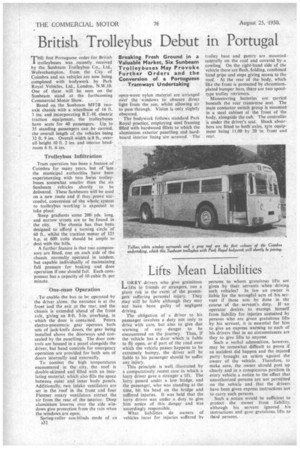Lifts Mean Liabilities
Page 34

If you've noticed an error in this article please click here to report it so we can fix it.
LLORRY• drivers who give gratuitous lifts to friends or strangers, run a grave risk in the event of the passengers suffering personal injury. They may still be liable although they may not have been guilty of negligent driving.
The obligation of a driver to his passenger involves a duty not only to drive with care, but also to give due warning of any danger to be encountered on the journey. Thus, if the vehicle has a door which is liable to fly open, or if part of the road over which the vehicle passes happens to be extremely bumpy, the driver will be liable to his passenger should he suffer any injury. This principle is well illustrated by a comparatively recent case in which a lorry driver gave a stranger a lift. The lorry passed under a low bridge, and the passenger, who was standing at the time, hit his head on the bridge and suffered injuries. It was held that the lorry driver was under a duty to give him notice of this danger and was accordingly responsible.
What liabilities do owners of vehicles incur for. injuries suffered by persons to whom gratuitous lifts are given by their servants when driving such vehicles? In law an owner is liable for the wrongful acts of his servant if those acts be done in the course of the servant's duty. If an operator desires to exempt himself from liability for injuries sustained by persons who are given gratuitous lifts by his servant, it is essential for him to give an express warning to each of his drivers that in no circumstances are they to give lifts to anyone.
Such a verbal admonition, however, may be somewhat difficult to prove if an accident did happen and the injured party brought an action against the owner of the vehicle. Therefore, to make sure, the owner should post up clearly and in a conspicuous position in every vehicle a notice to the effect that unauthorized persons are not permitted on the vehicle and that the drivers have been given express instructions not to carry such persons.
Such a notice would be sufficient to protect the owner from liability, although his servant ignored his instructions and gave gratuitous lifts to third persons.












































































